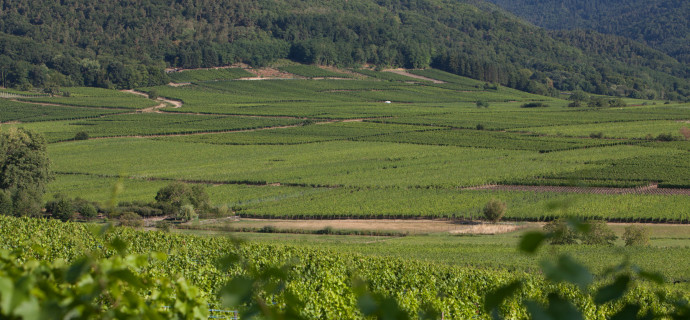Grands Crus
The authenticity of a region

Grand Cru Florimont
Between Ingersheim and Katzenthal
This Grand Cru is situated on south and east facing slopes of the lower hills of the Vosges. The soil is mainly marn and chalky, relatively stony. Thanks to the protection afforded by the Vosges mountains, the rainfalll is very slight. Gewurztraminer is the King of grape varieties here and it gives wines of great
length.
Florimont, the favourite of the Baron de Schwendi, a great supporter of Alsace viticulture, is one of the stars of the Cave Jean Geiler.

Grand Cru Sommerberg
Between Niedermorschwihr and Katzenthal
It is at the foot of the Trois-Epis on a steep slope at 400 metres with an orientation to the south. The granite is in the form of volcanic rock composed mainly of quartz crystal and micas, which have broken down to form a layer of heavy sand entitled granitic sand.
The site produces wines of great vivacity with a character more floral than fruity ; Riesling is especially successful.

Grand Cru Mambourg
Sigolsheim
Mambourg at Sigolsheim first mentioned in 783 for the quality and power of its wines. It is one of the earliest ripening sites in Alsace with excellent exposure to the sun. Calci-magnesique soil overlays outcrops of chalk and clay.
It is the Grand Cru for a special expression of Gewurztraminer, combining
elegance with longevity on the palate.

Grand Cru Wineck-Schlossberg
Between Ammerschwihr and Katzenthal
Wineck-Schlossberg first mentioned in writing in 1264. The hillside faces south, south–east between 280 and 400 metres. Granite soil with two types of
micas, very similar to the Sommerberg. Katzenthal is at the end of a valley and is thus sheltered from the wind ; the micro-climate is well suited to viticulture.
It is suited to Riesling but also for Gewurztraminer.

Grand Cru Kaefferkopf
Ammerschwihr
Situated on a hillside facing east at an altitude between 240 to 350 metres. The soil is quite varied with a sublayer of granite and chalk, but all has brown top soils with a strong concentration of calcium and magnesium that gives it typicity.
The first mention of Kaefferkopf was in 1338 in the cadastre of the Abbaye de Pairis in Ammerschwihr.
It has only recently gained its Alsace Grand Cru status, being the 51st vineyard to be accorded that honour.
The wines from Kaefferkopf are produced either from a single grape variety ( Gewurztraminer, Pinot Gros and Riesling ) or from a blend of all three varieties in strictly defined proportions.

Grand Cru Pfersigberg
Between Eguisheim and Wettolsheim
the Pfersigberg was mentioned in the 16th Century. The slopes facing east / south-east are particularly well exposed to the sun. The subsoil is of chalky rock, topsoil is marno calcaire with a strong calcium influence. Average water retention combined with serious warmth gives early maturing grapes.
The site favours Gewurztraminer where this grape develops concentration and elegance.

Grand Cru Hengst
Wintzenheim
Hengst at Wintzenheim vineyard facing to south / southeast at an altitude of 270 to 360 metres. The marn & chalky soil produces a strong character, assertive taste. It gives the wines structure and some fat as well as spicy aromas and is considered a wine of great ageing potential.
Gewurztraminer is particularly successful here.

Grand Cru Brand
Turckheim
At the entrance to the valley of Munster, this «fire earth» benefits from maximum sunshine at an altitude of 380 metres. Situated on a sub-strata of granite, it offers a sandy topsoil. The granite is particularly relevant for Riesling and Pinot Gris, to which it confers finesse, subtility and enhanced fruit definition.

Grand Cru Eichberg
Eguisheim
The vineyard is below three Chateaux. With a south-east exposure and an altitude of 220 to 340 metres, it benefits from a microclimate especially warm and dry, while the rainfall is the lowest in the whole region of Colmar. The soil is made up of chalk and is rich in small pebbles.
The wines from this terroir are mainly Pinot Gris and Gewurztraminer and are opulent in style.

Grand Cru Marckrain
Between Bennwihr and Sigolsheim
South of the village of Bennwihr, at the outflow of the Kaysersberg valley, the Marckrain rises over the famous wine route to a height of 200 to 300 m.
Its enjoy a very favourable east to south-east exposure and the well-known microclimate specific to the region of Colmar. Its soil is of limestone-marl type. Particularly favorable to Pinot gris and Gewurtzraminer, this soil gives heady, powerful wines with complex aromas.